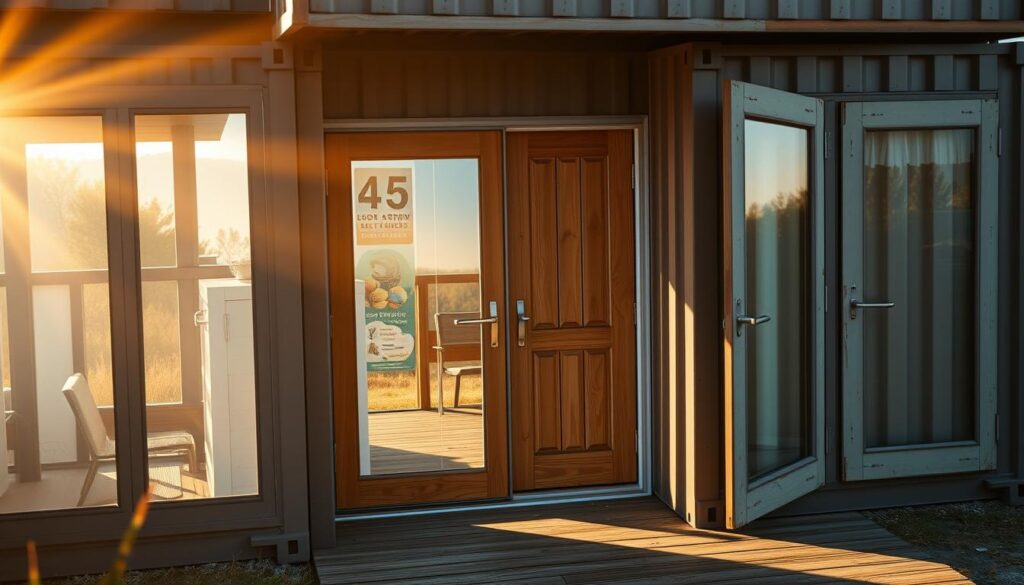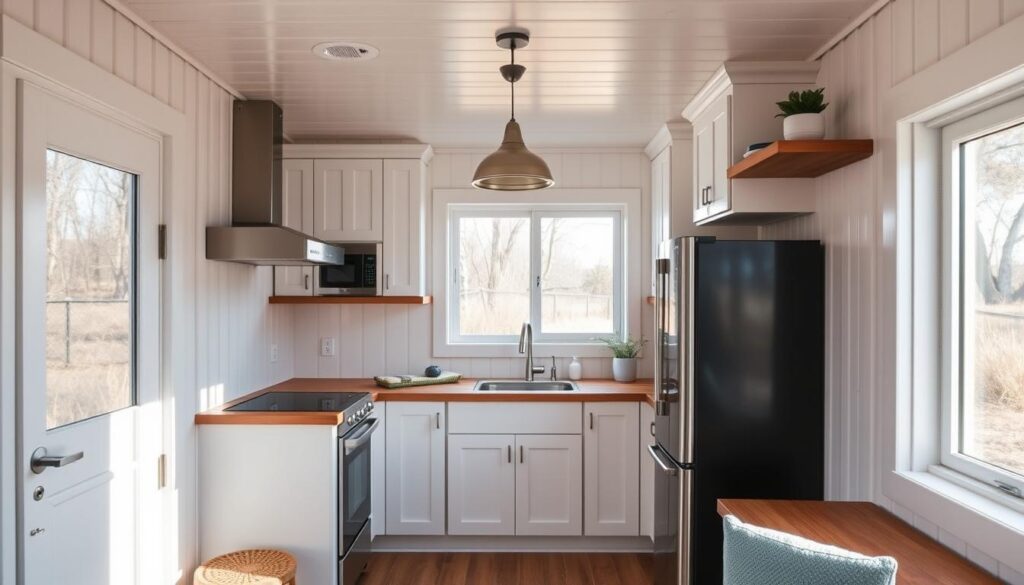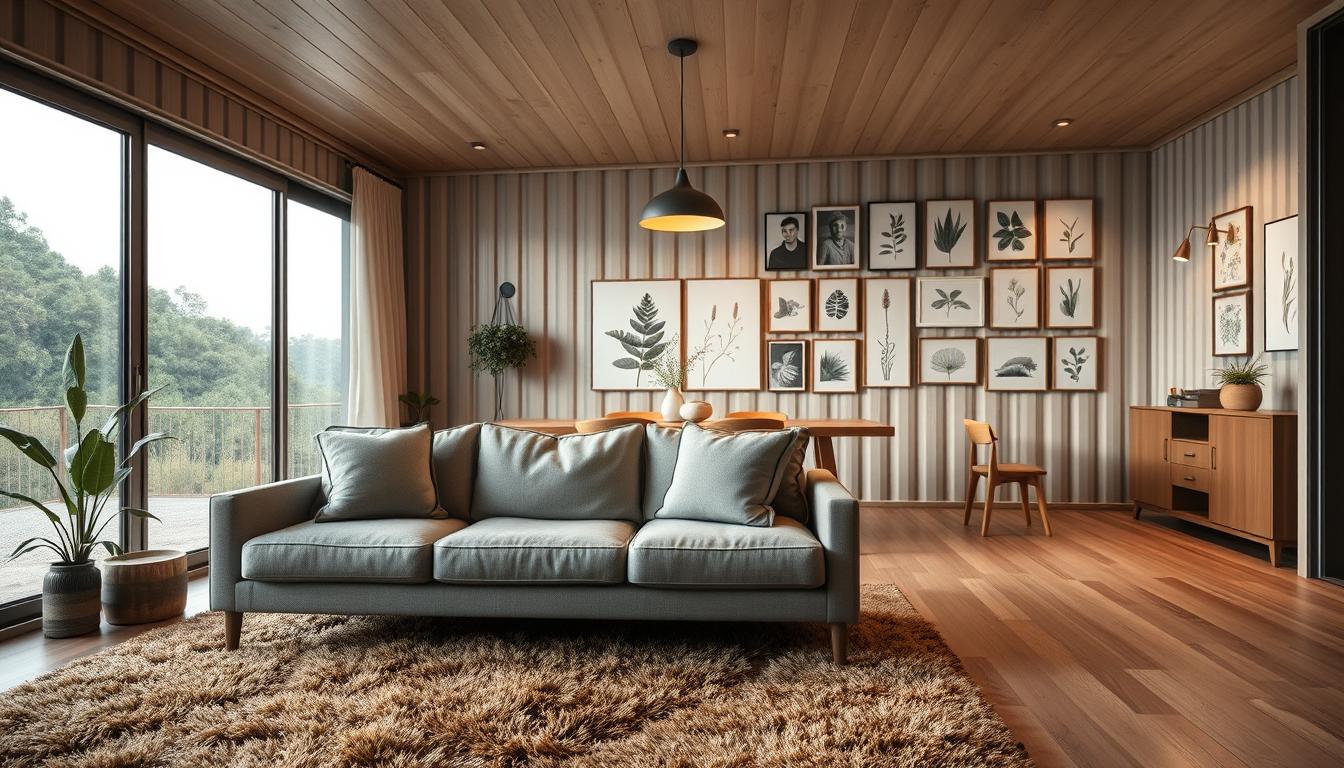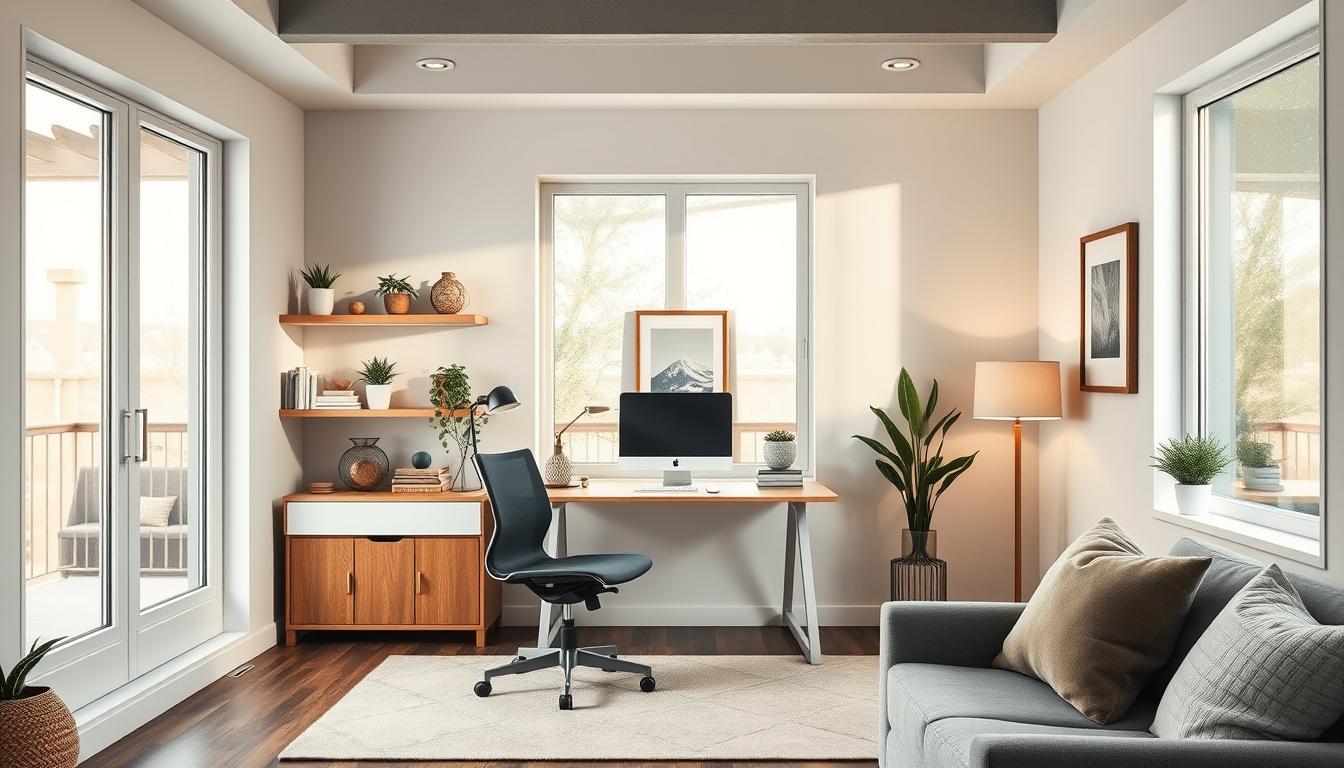Did you know over 20 million shipping containers are used worldwide? Many are turned into unique homes. The trend of living in sustainable and eco-friendly homes is growing. This makes interior design in these spaces very important.
We’ll look at the challenges and chances of shipping container homes. We’ll give tips on layout, lighting, and decor. This will help you make a space that’s both livable and beautiful.
Key Takeaways
- Maximizing space in small container homes
- Choosing sustainable materials for interior design
- Optimizing lighting for a cozy atmosphere
- Selecting decor that complements the container’s industrial style
- Creating a functional layout for comfortable living
Understanding Shipping Container Homes
Shipping container homes are becoming a popular choice for sustainable living. They are made from old shipping containers, combining function and eco-friendliness. Living in a shipping container might seem unusual, but it’s gaining fans for its green benefits and flexibility.
What Are Shipping Container Homes?
Shipping container homes are built from steel containers meant for shipping goods. Now, they’re turned into cozy homes, offices, and shops. This idea is not just creative; it’s also eco-friendly compared to traditional building materials.
To make a shipping container into a home, you add plumbing, electrical systems, and insulation. This makes the container a unique and functional living space.
Benefits of Container Living
Container living has many advantages, making it a great choice for a green lifestyle. Key benefits include:
- Eco-friendliness: Using shipping containers reduces waste and environmental impact.
- Cost-effectiveness: Containers are cheaper than traditional materials, making them an affordable housing option.
- Versatility: Containers can be customized and combined to fit any living need, from small to large spaces.
- Durability: Made of steel, containers are tough and can handle harsh weather, ensuring safety and security.
As we look into tiny house interior ideas and eco-friendly home decor, shipping container homes are a standout. They offer a unique way to live sustainably, reducing our environmental impact while creating spaces that reflect our style and values.
| Benefits | Description |
|---|---|
| Eco-friendliness | Reduces waste and minimizes environmental impact |
| Cost-effectiveness | Lower cost compared to traditional building materials |
| Versatility | Easily modified to suit individual needs |
| Durability | Withstands harsh weather conditions |
“The use of shipping containers for housing is a creative solution to the housing crisis and an eco-friendly alternative to traditional building materials.”
Key Elements of Interior Design
To make the most of a shipping container home, focus on interior design. The right choices can turn a small, industrial space into a cozy home. It’s all about enhancing the sense of space.
Color Schemes That Enhance Space
Choosing the right colors is key to making a shipping container home feel bigger. Light colors on walls and ceilings make the space seem larger. Accent colors add personality to the interior.
- Use light shades on larger surfaces.
- Add pops of color through furniture and decor.
- Consider the natural light available when selecting colors.
Furniture Selection for Compact Living
Choosing the right furniture is crucial in small spaces. Multi-functional furniture is perfect because it does more than one thing. It helps keep the space clutter-free and functional.
- Opt for sofas with built-in storage.
- Choose foldable tables and chairs.
- Invest in beds with drawers underneath.
Lighting Tips for Container Interiors
Good lighting can change the feel of a shipping container home. Layered lighting includes ambient, task, and accent lighting. It makes the space warm and inviting.
Think about adding LED strips under furniture or along ceilings to make the space feel taller. Also, skylights or larger windows let in natural light, making the space feel bigger.
Maximizing Space Efficiency
To get the most out of your shipping container home, think about using space-efficient designs. Making the most of space is key for a cozy living space in these homes.
Multi-Functional Furniture Ideas
Using multi-functional furniture is a smart way to save space. Items like sofa beds, storage ottomans, and foldable tables do more than one thing. They help keep your space tidy and make it more useful.
Adding upcycled furnishings to your design is also a good idea. It’s eco-friendly and gives your home a personal touch. You can find creative ideas for upcycled furniture that work well in shipping container homes.
Clever Storage Solutions
Shipping container homes need smart storage ideas because space is tight. Using wall-mounted shelves and storage units can really help. Also, hidden spots like under-bed storage or secret cabinets keep things organized and out of sight.
Adding industrial home decor like metal bins and reclaimed wood shelves is a great idea. They look good and help you save space. These touches also make your home stand out.
Creating a Cozy Atmosphere
A cozy shipping container home is achievable through careful selection of textures, fabrics, and natural elements. To create a warm and inviting atmosphere, it’s essential to consider the sensory details that make a space feel like home.
Textures and Fabrics That Comfort
The right textures and fabrics can significantly enhance the comfort of a shipping container home. Soft fabrics like cotton, linen, and wool can add warmth and coziness to the space. Consider incorporating throw blankets, rugs, and pillows in these materials to create a inviting atmosphere.
For a more sustainable interior design, opt for eco-friendly fabrics and materials. Recycled textiles, organic cotton, and natural fibers are excellent choices that not only comfort but also support the environment.
| Material | Eco-Friendliness | Comfort Level |
|---|---|---|
| Organic Cotton | High | High |
| Recycled Polyester | Medium | Medium |
| Linen | High | High |
Incorporating Nature into Design
Bringing the outdoors in is a great way to enhance the coziness of a shipping container home. Eco-friendly home decor ideas include using natural elements like wood, stone, and plants. These elements not only add visual warmth but also help purify the air and improve the overall ambiance.
Consider adding a living wall or a few potted plants to your container home. Not only do they improve air quality, but they also contribute to a sense of well-being and connection to nature.
Essential Utilities for Container Homes
Utilities are key to making a shipping container a cozy home. When designing a tiny house interior, it’s important to think about the essential utilities. These utilities make a container home both livable and comfortable.
Electrical Requirements
Electrical systems are a major concern for container homes. A typical shipping container home needs a reliable electrical supply. This supply powers appliances, lighting, and other necessities.
Key Considerations for Electrical Systems:
- Assessing power needs based on the size of the container and the number of occupants
- Installing appropriate electrical wiring and outlets
- Ensuring compliance with local electrical codes and regulations
Plumbing Requirements
Plumbing is crucial for container homes, mainly for bathrooms and kitchens. The plumbing system must be efficient, durable, and safe.
Important Plumbing Considerations:
- Selecting the right materials for pipes and fixtures
- Designing the plumbing layout to minimize waste and optimize water flow
- Ensuring proper insulation and protection of pipes from extreme temperatures
Sustainable Energy Options
For those living in small spaces, using sustainable energy can greatly reduce carbon footprint. Renewable energy sources like solar and wind power are good alternatives to traditional energy.
| Energy Source | Benefits | Considerations |
|---|---|---|
| Solar Power | Renewable, reduces electricity bills | Initial investment, requires sunlight |
| Wind Power | Renewable, can be cost-effective | Dependent on wind speeds, may require permits |
By planning and installing the right utilities, container homes can be both functional and sustainable. They offer a unique living experience that fits with tiny house interior ideas and small space living principles.
The Role of Windows and Doors
Choosing the right windows and doors is key to a great industrial home decor and minimalist interior design in shipping container homes. They let in natural light and air, shaping the look and feel of your space.

Choosing the Right Windows
When picking windows, think about size, style, and material. Big windows can open up a room, while small ones can make it cozy. Sliding windows and awning windows are good choices for their ease and function.
Energy-efficient windows help keep your home comfy without needing to heat or cool it. Also, pick windows that fit your minimalist interior design to keep things simple and clean.
Door Styles That Complement Design
The front door of your home is more than just a way in. It’s a design statement. Industrial-style doors with simple lines are often chosen. They can be made from steel, wood, or both, for a strong and stylish look.
For inside doors, sliding barn doors or pocket doors are smart choices. They save space and keep your home feeling open. These doors also fit well with the industrial home decor theme, making your home look cohesive.
By picking the perfect windows and doors, you can make your shipping container home both beautiful and functional. It will be a unique and welcoming place.
Flooring Options for Container Interiors
Turning shipping containers into homes means choosing the right flooring is key. It makes the space look good and feel comfortable. The right flooring adds beauty and function to your home.
Popular Flooring Materials
When picking flooring for your container home, look for materials that last, are good for the planet, and easy to care for. Here are some top picks:
- Eco-friendly hardwood flooring, which adds warmth and character to the interior.
- Reclaimed or upcycled wood, a great choice for those looking to incorporate sustainable and unique elements into their decor.
- Porcelain or ceramic tiles, known for their durability and resistance to moisture, making them ideal for container homes.
- Laminate or engineered wood, cost-effective alternatives that mimic the look of hardwood.
Each material has its own benefits. Your choice depends on what you like, your budget, and your home’s needs.
Maintenance Tips for Container Flooring
To keep your container home’s flooring looking great, regular care is essential. Here are some tips:
- Regular Cleaning: Sweep or vacuum often to remove dirt and debris that can scratch or damage the flooring.
- Moisture Control: Watch out for moisture, as it can harm your flooring, more so in wet areas.
- Protective Coatings: Use protective coatings or sealants to make your flooring last longer and clean easier.
- Prompt Repairs: Fix any damage or wear quickly to avoid bigger problems.
Choosing the right flooring and following these care tips will help you enjoy a beautiful, functional, and eco-friendly home for many years.
Kitchen Design Ideas
Kitchen design in shipping container homes is about mixing looks and use in a small space. We must think about the special challenges and chances of the container’s shape when designing a kitchen.
Efficient Layouts for Container Kitchens
To make the most of space, we can use a few strategies. A galley or L-shaped kitchen layout is great. It makes the workflow efficient and comfy.
- Use wall-mounted shelves and cabinets to clear the floor and make the space bigger.
- Choose multi-functional appliances, like a microwave-toaster oven combo.
- Think about a kitchen island or cart for more counter space and storage.
Essential Appliances for Small Spaces
Choosing the right appliances for a shipping container home kitchen is key. We should look for compact and energy-saving models. Some must-haves include:
| Appliance | Compact Option | Energy Efficiency |
|---|---|---|
| Refrigerator | Under-counter fridge | Energy Star rated |
| Dishwasher | Compact dishwasher | Low water consumption |
| Oven/Stove | Single unit combo | Induction cooking |
By picking the right appliances and designing a smart layout, we can make a kitchen in a shipping container home that’s both useful and stylish.

Bathroom Solutions for Shipping Containers
Turning a shipping container into a cozy home means focusing on the bathroom. We’ll look at how to make a bathroom that’s both useful and comfy, even in a small space.
Space-Saving Layouts
With little room, the bathroom’s layout is key. We can use wall-mounted sinks and toilets to free up floor space. Choosing a shower stall over a bathtub also saves room.
Eco-Friendly Fixtures to Consider
Using eco-friendly fixtures cuts down on waste and boosts the home’s greenness. Options include low-flow showerheads and toilets, and LED lights for the bathroom.
| Fixture | Benefits |
|---|---|
| Low-Flow Showerheads | Water conservation, reduced utility bills |
| Dual-Flush Toilets | Water efficiency, customizable flush options |
| LED Lighting | Energy efficiency, longer lifespan |
By picking these eco-friendly options and designing smartly, we can craft a bathroom that’s both practical and green.
Personalizing Your Space
A shipping container home is more than a place to live; it’s a blank canvas. We’ll explore industrial home decor and minimalist interior design to make it uniquely yours. Personalizing your space means it should show off your personality and style.
Artwork and Décor Choices
Decorating your shipping container home offers endless possibilities. You can go for a minimalist look, keeping things simple, or choose an industrial vibe to highlight the container’s features. The right artwork and decor can really set the mood of your home.
Think about adding pieces that show your interests or travels. Vintage maps or abstract art can make your walls stand out. Adding natural elements like wood or plants can also warm up your space.
Making the Most of Wall Space
Wall space is precious in any home, but even more so in shipping container homes. To make the most of it, use decor or shelving that serves more than one purpose. This can hold books, decorations, or kitchen items.
Designing your home should be intuitive and simple, as famous designer quotes suggest. In a shipping container home, less is often better. Choosing a few key pieces and keeping things minimalist can make your space feel open and airy.
“The way you decorate your home says a lot about you.”
Using tall shelving or storage units can also help keep your floor clear. This makes the area feel bigger. Plus, adding mirrors can make your space seem even larger by reflecting light and images.
- Use wall-mounted shelves for storage.
- Hang artwork or mirrors to create the illusion of space.
- Incorporate natural elements like plants or wood accents.
Case Studies: Successful Shipping Container Homes
Looking at successful shipping container homes gives us great ideas for design and living green. We see how to use space well and add eco-friendly touches.
Innovative Designs
Some shipping container homes have become famous for their creative interiors. They use green design to cut down on environmental harm and create special living areas. These homes often have furniture that does more than one thing and smart storage, making the most of the space.
Lessons from Homeowners
People who’ve turned containers into homes share important tips. They say planning and being flexible are key. By focusing on what they need and want, they make homes that are both useful and beautiful, showing off their personal style.
Learning from these examples, future container homeowners can get ideas and useful tips. This helps them make a smooth transition to living in a container in a sustainable way.


